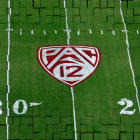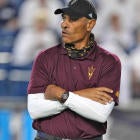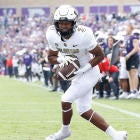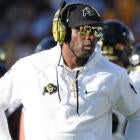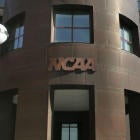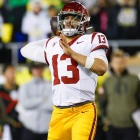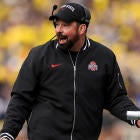The beginning of one of the biggest Pac-12 football games of last season was preempted by a NASCAR truck race. When it became apparent the Lucas Oil 150 was going to run long, FS1 delayed the Stanford-Washington game by 15 minutes to 10:45 p.m. ET.
It wasn't enough of a delay. Even though the game was shifted to little-seen FS2 and the Fox Sports app, thanks to the trucks -- and Fox's commitment to them -- most viewers missed the entire first quarter.
"That was unfortunate," Pac-12 commissioner Larry Scott said recently. "I was not happy about that. … There were definitely [people] upset about that."
Scott is proud to say such an occurrence will no longer happen. The Pac-12 was assured by Fox officials a couple of weeks ago that, were there to be a future conflict, conference games will be shifted to … Fox Business Channel.
There is something to be said for small victories: Lou Dobbs over racin' trucks.
Before digging down on the Pac-12's current place in the Power Five, you must ask this basic question: Would any of that have happened in the Big Ten or the SEC -- the two strongest, most prosperous and (some would say) best-run conferences?
"I'm fairly critical of the Pac-12 organization," Cal chancellor Carol Christ said late last year.
That was before the Pac-12 extended the Power Five's longest national championship drought in football to 14 years. That was before cementing the worst bowl record in the conference's history (1-8).
That was before the entire league got knocked out of the NCAA Tournament prior to the second round for the first time in 32 years. That was before the latest revenue figures cemented the league at No. 5 in Power Five in revenue.
Of course, the Pac-12 spun that $509 million payout as the largest in its history. And while that's true, it's not how Arizona State athletic director Ray Anderson saw it.
"The gap between us and the other [leagues] continues to grow," he said. "We'll be competitively disadvantaged even moreso. … That's real money in terms of being able to compete, support facilities, support coaches and support programs."
The sky is not falling out West but cracks are beginning to appear in a once-solid foundation. First, there are those vocal critics. Christ, Anderson and new Washington State president Kirk Schulz have weighed in.
"This is a concern of the Pac-12 presidents, and I can tell you it's a large discussion point with meetings with the commissioner at every single meeting," Schulz said. "… The Pac-12 schools have got to be competitive with the ACC, the SEC and the Big Ten and Big 12, and we're falling behind."
- How far behind? Pac-12 schools took in an estimated $2.5 million each from the much-maligned Pac-12 Networks. LSU has a defensive coordinator (Dave Aranda) who makes that much by himself.
- Pac-12 schools average $30.9 million in annual revenue. The SEC is No. 1 at $41 million. That $10 million difference could be the difference in paying a top-notch coach. (Note: UCLA's Chip Kelly and Stanford's David Shaw are among the top 10 among highest-paid coaches.) "Is [that gap] going to become $20 million in the not-too-distant future?" Anderson asked.
- Is it time to start calling it the Power Four? Now four years into the College Football Playoff era and 20 years since the Bowl Championship Series started, the Pac-12 has the Power Five's fewest total appearances (five).
If this was a country club, the Pac-12 would be in danger of losing its membership.
Scott, college sports' highest-paid commissioner, oversees a struggling network in a distant time zone.
Two of his basketball programs (USC and Arizona) are under FBI scrutiny.
At least Fox Business can be seen in 80 million households.
Football produces the overwhelming majority of the revenue listed above, and we live in an era where you are who you get in the playoff. The Pac-12 is tied with the Big 12 for fewest CFP appearances at two.
The difference is that, last year, Oklahoma stormed to the Rose Bowl semifinal with a Big 12 title led by Heisman Trophy winner Baker Mayfield. Every team in the Pac-12 finished with at least three losses.
"Our schools have been great about boxing above their weight level, historically," Scott said this month in a statement that resonated around the league. "Our schools do perhaps more with less."
Yikes. When is the last time you heard Greg Sankey say something like that about the SEC?
"I think these things are somewhat cyclical and have blips," Scott said.
Fashion is cyclical. The seasons are cyclical. Championships are forever, and right now, the Pac-12 has a perception problem.
It would be nice to get out in front of something.
Football scheduling is a major issue. Kevin Sumlin was allowed to all but close spring practice to the media at Arizona. This one year after former coach Rich Rodriguez was sued by his former administrative assistant.
That might make it easier to write about Herm Edwards up the road at Arizona State. That also makes it easier to write this column.
"The Pac-12 needs to do a better job in being cohesive with their messaging," Fox Sports analyst Joel Klatt said.
Klatt accurately pointed out that Pac-12 champion USC was dismissed out of hand in the discourse about the playoff despite an 11-2 regular-season record.
"When your premier brand [USC] has a legitimate argument to be in the discussion for the playoff and is a non-factor … that is a conference problem," Klatt added.
Klatt also noted, again accurately, that USC played 12 consecutive weeks with no byes. The last 11 of those games were against Power Five opponents.
Alabama did not win its conference, played only eight Power Five opponents and enjoyed two byes. And yet, the Tide got to the playoff.
"That's absurd," Klatt said. "That's not even in the same hemisphere as the same difficulty."
Did you hear any of that from the Pac-12 itself?
Last season, four Pac-12 teams had to play Friday night road games just six days after playing a Saturday night road game.
Guess what? All four teams lost, most notably USC getting ambushed at Washington State, 30-27, on Sept. 29, 2017.
"That loss probably holds [us] out," Trojans coach Clay Helton said in reference to the CFP.
Scott says the conference has resolved the scheduling issue. Meanwhile, that conference revenue gap isn't going to change anytime soon.
Geography makes the Pac-12 the most far-flung conference. There are more people in the Big Ten footprint. The SEC … do you have to be told? "It just means more."
It's not harsh to call the Pac-12 Networks a failure -- at least in comparison to its Big Ten and SEC peers.
"No one is satisfied with the [revenue] production of the Pac-12 Network," Anderson said.
It may be until the conference's next media rights deal expires -- in 2023 -- for that network to be valued as highly as the Pac-12 views it.
It may be until Facebook jumps in and streams the conference until a Pac-12 network makes any kind of economical sense. In retrospect, it was a mistake not to find a partner to share the cost of the network. A potential deal for carriage on DirecTV never developed.
Not included in the news of that revenue distribution was the Pac-12 handing out only 73 percent of its annual take to its members. The rest of the Power Five conferences typically distribute more than 90 percent.
Scott says that's an accounting issue. Since the Pac-12 doesn't have that partner to defer the cost of its network, it has to report the expenses all on its own.
"We've never had more revenue," Scott said.
And there's never been more ways to spend it. Except, as the highest-paid commissioner at $4.8 million annually, Scott makes more than three Division I athletic departments are worth.
The league is staking its comeback on five new coaches: Kelly, Sumlin, Edwards, Mario Cristobal (Oregon) and Jonathan Smith (Oregon State).
That's a good start. Kelly is the game's winningest active coach. Sumlin has coached a Heisman winner. Cristobal has two national championship rings, one as a Miami player and one as an Alabama assistant.
Balancing those hires is the loss of two top-10 draft quarterbacks -- Sam Darnold and Josh Rosen.
Scott reportedly has a base of support among Pac-12 CEOs -- most notably Oregon State's Ed Ray and Arizona State's Michael Crow. But the league's diminishing stature may have crushed the league's most ambitious dream from ever being realized.
In 2010, Scott made a bold play for four Big 12 schools in a move that would have expanded the league to 16 teams and reshaped college athletics.
Now? It's hard envisioning Texas and Oklahoma from the Big 12 placing their futures with the Pac-12. In two years, both schools will be earning approximately $50 million each in annual media rights.
There was also a prickly situation last season between Washington and its largest media partner. After Huskies coach Chris Petersen complained about the lateness of kickoffs, ESPN's Kirk Herbstreit said UW "should be thanking" the network for airing its games. During an ESPN broadcast later that night, three actual cupcakes were lined up on the field as a method of illustrating the Huskies nonconference opponents last season (Rutgers, Montana, Fresno State).
"There was definitely [people] upset about that. No question," Scott said.
All of it begged the question that defines the Pac-12 these days: Would any of that have ever happened in the Big Ten or SEC?












